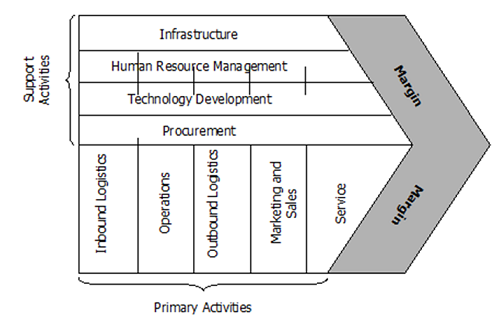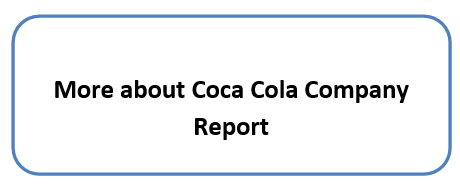Coca Cola Value Chain analysis
Value-chain analysis is an analytical framework that assists in identifying business activities that can create value and competitive advantage to the business. The figure below illustrates the essence of value chain analysis.
Inbound logistics. Water is the main ingredient for all products manufactured by Coca Cola Company and the company occasionally faces significant challenges in accessing this particular raw material. Coca Cola uses high fructose corn syrup (HFCS) extensively and this raw material is purchased from US-based suppliers and delivered via trucks. There are also some ingredients that have to be sourced internationally. For example, orange juice and orange juice concentrate is sourced from Florida and Southern Hemisphere, particularly Brazil. For international purchases inbound logistics are facilitated via ships and trucks. Coca Cola values diversity among its suppliers. In 2013, $952 million were spent on diverse suppliers, an increase of 14.8% compared to the previous year.
Operations. Coca-Cola operating segments are divided into the following 7 groups:
- Eurasia and Africa
- Europe
- Latin America
- North America
- Asia Pacific
- Bottling Investments
- Corporate
The Coca Cola system is not a single entity from legal and managerial points of view. Coca Cola manufactures and sells concentrates, beverage bases and syrups to its bottling partners, maintains ownership of the brand and develops and applies marketing strategy. Bottling partners, entities that do not belong to Coca Cola, do manufacturing, packaging, merchandising and they distribute the final product to customers and vending partners.
Outbound logistics. Coca Cola Company sells its products in more than 200 countries and understandably claims to operate the world’s largest beverage distribution system[1]. Distribution channels utilized by Coca-Cola consists of distribution operations operated or controlled by the company, independent bottling partners, distributors, wholesalers and retailers. The five major bottling partners listed in Table 3 accounted for 33% of the total unit case volume sales in 2014. Moreover, outbound logistics are organized via manual distribution across Africa with more than 2500 independent manual distribution businesses employing more than 11,000 people[2].
| Independent bottling partner | Areas covered |
| Coca-Cola FEMSA, S.A.B. de C.V. (“Coca-Cola FEMSA”) | Northeast parts of Mexico, Brazil, Guatemala, Colombia, Costa Rica, Nicaragua, Panama, Venezuela, western Argentina and Philippines |
| Coca-Cola HBC AG (“Coca-Cola Hellenic”) | Armenia, Austria, Belarus,
Bosnia-Herzegovina, Bulgaria, Croatia, Cyprus, the Czech Republic, Estonia, the Former Yugoslav Republic of Macedonia, Greece, Hungary, Italy, Latvia, Lithuania, Moldova, Montenegro, Nigeria, Northern Ireland, Poland, Republic of Ireland, Romania, Russia, Serbia, Slovakia, Slovenia, Switzerland and Ukraine |
| Arca Continental, S.A.B. de C.V | Western Mexico, Ecuador and northern Argentina |
| New CCE | Belgium, continental France, Great Britain, Luxembourg, Monaco,
the Netherlands, Norway and Sweden |
| Swire Beverages (“Swire”) | Hong Kong, Taiwan, seven provinces in mainland
China and territories in 11 states in the western United States |
Table 3 Major bottling partners and areas they serve[3]
Marketing and sales. Sales of beverages belonging to Coca-Cola portfolio amounted to 28.6 billion, 28.2 billion and 27.7 billion unit cases in 2014, 2013 and 2012, respectively. The volume of sales in the home country US accounted for 19% to the total volume of sales in 2014[4]. 31% of total sales outside of the US occurred in Mexico, China, Brazil and Japan.
Coca Cola applies integrated marketing strategy using advertising, sales promotions, events and experiences and public relations elements of the marketing mix in a combined manner. The brand marketing message is associated with being happy, enjoying life and leading an active lifestyle. Coca Cola’s the latest marketing efforts have been directed at combining four popular drinks – Coca Cola, Diet Coke, Coca Cola Zero and Coca Cola Life into the concept of ‘One Brand’, thus providing wider choice to the target customer segment.
Service. Coca Cola maintains its customer service practices via online chat with a virtual agent in official website of the company dedicated customer service phone. Coca Cola website has a comprehensive FAQ that covers the most aspects of their products in a detailed manner and the website also addresses a wide range of rumors related to the brand direct and indirect ways.
Coca Cola Company Report contains more detailed discussion of Coca Cola value-chain analysis covering analysis of support activities. The report also comprises application of SWOT, PESTEL and Porter’s Five Forces Analyses on Coca Cola Company, along with analysis of Coca Cola’s marketing strategy and company’s approach towards Corporate Social Responsibility (CSR).
[1] Annual Report (2014) Coca-Cola Company
[2] Clinton, B. (2009) Harvard Business Review, Available at: https://hbr.org/2009/09/creating-value-in-an-economic-crisis
[3] Annual Report (2014) Coca-Cola Company
[4] Annual Report (2014) Coca Cola Company


